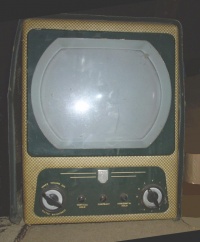Appliance energy saving
How to assess the energy saving of a new product, to decide whether its worth replacing to cut costs.
TV example
In considering replacing a CRT TV...
First you need to know the power consumption of the 2 sets you want to compare. The label on the set indicates the max consumption, and figures can be calculated from those. If you want more precision, you'd hook the 2 upto an energy consumption meter (killawatt etc) and measure their consumption exactly.
Example:
Say a CRT TV eats 100w and you watch it for 2 hr per day. (I'm picking easy figures)
- Consumption = 0.1kW x 2hrs = 0.2kWh per day = 73kWh / yr
- Price of electricity = 12p/kWh
- So annual energy cost = 73 x 12p = £8.76 / yr
- If typical life expectancy of appliance = 8 yrs, thats £70 of electricity per life of the product.
Now compare an LCD with 70w consumption
- elec cost = £6.13/yr = £49/ 8yrs
- Difference = 70-49 = £21
The purchase price is greater than the electricity saving, so the LCD never pays its savings back.
Fridge freezer example
A faulty 70w fridge freezer runs continuously. Is it worth replacing?
0.07kW x 24hrs x 365 days = 613kWh/yr x 13.5p = £83 per annum run cost x 10 yrs = £830 run cost New machine rated to eat 0.75kWh/day = 274kWhpa x 13.5p per kWh = £35.59 /yr x 10 yrs = £356 run cost + £320 purchase cost = £676 total cost
Thus a brand new machine works out £154 cheaper over 10 years than keeping the old one.
Real consumption
Ratings plates give maximum consumption, and this isn't always the same as real world consumption. Most LCD TVs & monitors consume the same power regardless of program content, CRT power consumption varies according to picture brightness, thus is below max rating a lot of the time. So in practice the figures are more in favour of the CRT set than the ratings plates suggest.
